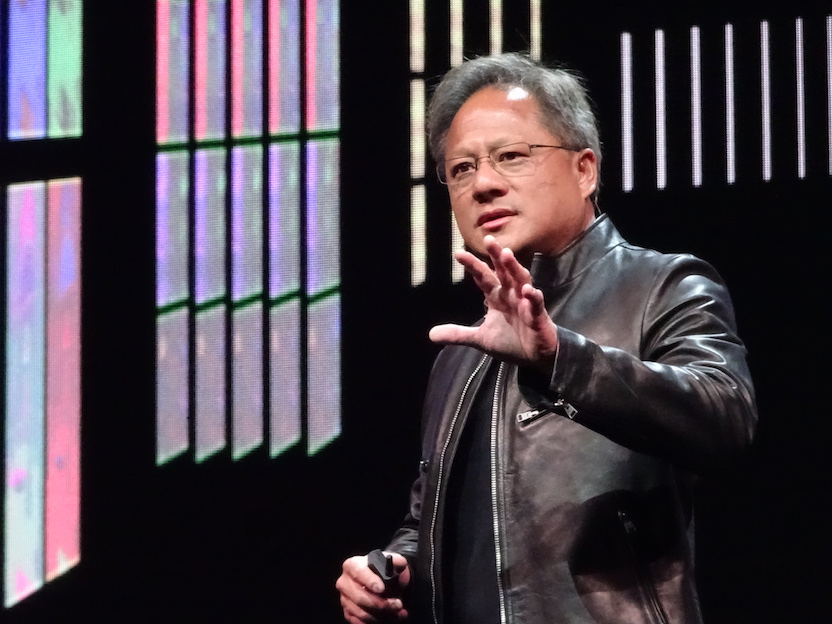 INFRA
INFRA
 INFRA
INFRA
 INFRA
INFRA
Nvidia Corp. rocketed to semiconductor fame with its graphics processing units that helped create the hottest gaming personal computers, but today its original market almost looked like an afterthought.
The company introduced a powerful new chip at its GPU Technology Conference in San Jose, California, that’s tuned in a number of ways for what Chief Executive Jensen Huang (pictured) said is the next era of computing: artificial intelligence, in particular deep learning neural networks that are responsible for recent breakthroughs such as self-driving cars and instant language translation.
The Tesla V100 (below) boasts five times the computing power than the Pascal chip introduced last year, the company’s first non-gaming chip. It’s based on a new Volta chip architecture that packs some 21 billion transistors on a single large chip about the size of an Apple Watch face. Huang implied that Nvidia spent billions to develop it, telling the audience, “If anyone would like to buy this, it’s $3 billion,” before stashing it in a back pocket.
The chip is specifically made for deep learning applications, for which the chip is 12 times faster than last year’s chip in the measure called Tensor floating-point operations per second. Today, Nvidia saw its shares soar 18 percent after it reported better-than-expected first-fiscal quarter results Tuesday driven partly by a near-tripling of chips into data centers run by cloud computing leaders and companies doing deep learning.
Nvidia added a number of features tuned for deep learning, including some 640 “Tensor Cores,” or specialized circuits for speeding up AI workloads. There are also speedier interconnections between GPUs and standard central processing units, higher-speed memory circuits, and software such as Nvidia’s new TensorRT that figures out which mathematical operations can be done much faster in parallel rather than sequentially like on a standard CPU.
![]()
Indeed, Huang made the case that as conventional central processing units like those made by Intel Corp. are seeing limits to their ability to double the number of transistors on a single chip every two years, a decades-long trend known as Moore’s Law, Nvidia’s parallel style of processing is positioned to take the lead in chip progress.
“We’re now up against the laws of semiconductor physics,” he said. “As Moore’s Law comes to an end, accelerated computing provides a good path forward.”
It’s an angle Huang has been hammering on lately, and for good reason. His company’s graphics chips happened to be ideal for the highly parallel operations needed for data crunching machine learning requires. But other companies are now crafting their own chips even more finely tuned for deep learning, including Google Inc. with its Tensor Processing Units used in its own data centers and Intel Corp. with field-programmable gate arrays and other chips it now has through recent acquisitions.
The new chip will be available in the third quarter in a new Nvidia DGX-1 supercomputing appliance, which will cost $149,000. The chip also will be available to other computer makers and, in a machine called the HGX-1, to cloud computing providers in the fourth quarter. Nvidia also announced a smaller Volta-based computer for individuals, called the DGX Station, which will be available in the third quarter for $69,000.
The technology will be available via the cloud as well. The Nvidia GPU Cloud is a “stack” of software that includes deep learning software frameworks such as TensorFlow, Theano and MXNet. It can run on a single personal computer, Nvidia’s DGX-1 or in the cloud.
Huang also announced that Toyota has decided to use Nvidia’s Drive PX, its computer system for cars. “This will be the architecture for their future driverless cars,” he said. Nvidia also has partnerships with other car makers such as Audi, Tesla, Mercedes and Volvo. The system includes a chip called Xavier that combines and ARM CPU, a Volta GPU and a deep learning accelerator. The chip architecture will be made available by open source starting in July for selected customers with a general release in September.
Not least, the company announced a robotic simulator called Isaac that can run on any Nvidia GPU. The potential, Huang said, is to pretrain a robot using deep learning. “The robot can wake up almost as if it was born to know this world,” he said.
Still, Nvidia didn’t completely forsake its high-quality graphics roots, showing off hyper-realistic video game snippets. It also introduced an experiment called Project Holodeck, whose real-time avatar-based collaboration is intended to showcase the potential for more interactive virtual reality.
In any case, said Karl Freund, senior analyst at Moor Insights & Strategy, Nvidia will be able to use much of the same technology in chip modules aimed at gaming, which still constitutes a large majority of Nvidia’s business. “Deep learning is driving specific features like reduced precision, but the architecture can then be subsequently pruned to deliver efficient gaming products,” he said.
Support our mission to keep content open and free by engaging with theCUBE community. Join theCUBE’s Alumni Trust Network, where technology leaders connect, share intelligence and create opportunities.
Founded by tech visionaries John Furrier and Dave Vellante, SiliconANGLE Media has built a dynamic ecosystem of industry-leading digital media brands that reach 15+ million elite tech professionals. Our new proprietary theCUBE AI Video Cloud is breaking ground in audience interaction, leveraging theCUBEai.com neural network to help technology companies make data-driven decisions and stay at the forefront of industry conversations.